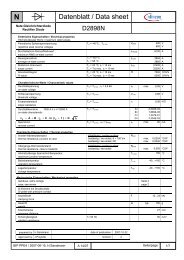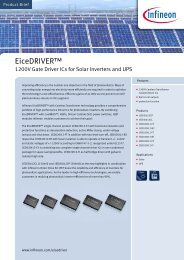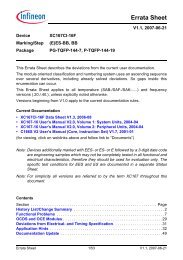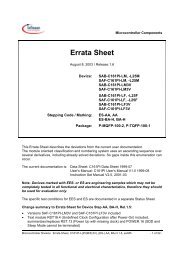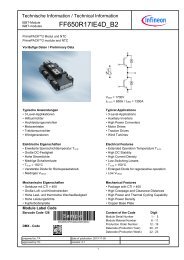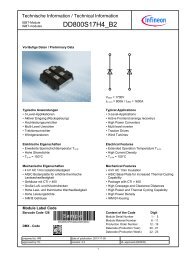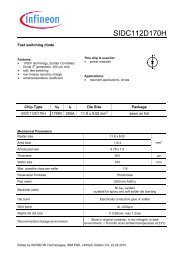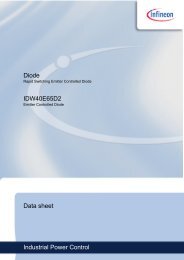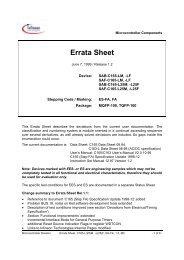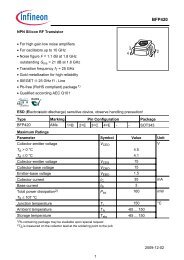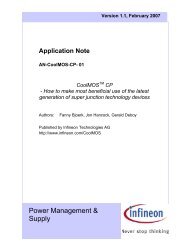Errata Sheet - Infineon
Errata Sheet - Infineon
Errata Sheet - Infineon
Create successful ePaper yourself
Turn your PDF publications into a flip-book with our unique Google optimized e-Paper software.
<strong>Errata</strong> <strong>Sheet</strong><br />
XC161CS-32F, (E)ES-BB, BB<br />
Application Hints<br />
SCU_X.H8 PLL Bypass Mode with VCO on<br />
In bypass mode with VCO running as oscillator watchdog OWD<br />
(PLLCON.PLLCTRL=01 B ) it is recommended to configure f in to a value that does not<br />
allow the PLL to lock with f VCO /(PLLCON.PLLMUL+1). This can be achieved by using an<br />
appropriate VCO band in combination with PLLCON.PLLMUL=0 H , e.g. PLLCON=2080 H ,<br />
such that f in =f OSC /(PLLCON.PLLIDIV+1) is lower than f VCO_base (see table below).<br />
Otherwise, when f in is at the transition between a lock and an unlock operation of the<br />
PLL, the internal master clock f MC may not reach the intended target frequency, but is set<br />
to f OSC /((PLLCTRL.PLLIDIV+1)*16), i.e. PLLODIV is set to the maximum value of 0F H .<br />
When a clock failure (e.g. crystal break) occurs, the PLL may not switch to emergency<br />
mode and the device stops.<br />
Table 8<br />
Relation between maximum f in and VCO Band Selection<br />
PLLCON.PLLVB VCO base frequency f VCO_base Maximum f in<br />
0 20 MHz < 20 MHz<br />
1 40 MHz < 40 MHz<br />
2 60 MHz < 60 MHz<br />
SCU_X.H10 Register Security Mechanism usage with CPUCON1 and CPUCON2<br />
registers<br />
When using the register security mechanism in conjunction with protected registers<br />
CPUCON1 or CPUCON2, CPU pipeline effects must be taken into account. When using<br />
Secured Mode (bitfield SL = 01 B in register SCUSLS), command 4 of the unlock<br />
sequence will update the SCUSLS register in the write back stage of the pipeline. But,<br />
the registers CPUCON1 and CPUCON2 belong to the class of registers known as CPU<br />
core SFRs (CSFRs), and updates to these registers occur one cycle earlier, in the<br />
execute stage (see User’s Manual, chapter 4.3 ’Instruction Processing Pipeline’).<br />
Attempting to write one of the CPUCONx registers immediately after command 4 of the<br />
unlock sequence will cause the write operation to the CPUCONx register to occur before<br />
the unlock sequence is in effect. Therefore, the CPUCONx register will not be updated<br />
as expected (see also CPU_X.D1).<br />
To avoid this effect, it is generally recommended to initialize the CPUCON1 and<br />
CPUCON2 registers during software initialization, before the EINIT instruction is<br />
executed. Until EINIT, the Unsecured Mode is active and no unlock sequence is<br />
required.<br />
<strong>Errata</strong> <strong>Sheet</strong> 39/50 V1.1, 2007-06-21



